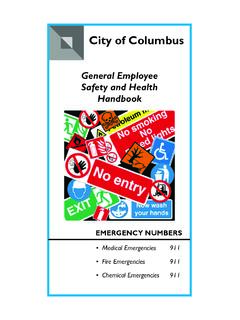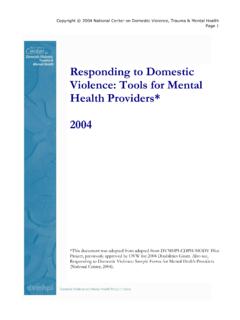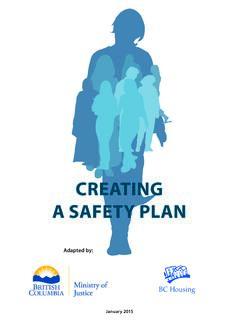Transcription of How to Meet OSHA’s Employee Training Requirements
1 How to Meet osha 's Employee Training Requirements A Quick Guide for Medical, Dental, and Other Ambulatory Care Settings A supplement to Medical Environment Update Dear reader, Survey responses and calls to the osha consultation hotline, which is a benefit of subscribing to Medical Environment Update, have shown that Training your employees for compliance with osha standards is one of your major responsibilities. Indeed, keeping up with osha 's required Employee Training for a variety of individual standards can seem like a daunting task especially considering that busy medical professionals are strapped with administrative and patient care duties. With this in mind, I have decided to offer this special report that explains exactly what topics you need to cover when Training employees and suggesting interesting ways to impart that information in medical prac- tices, dental practices, and other ambulatory care settings. Sheila Dunn, DA, MT (ASCP), and Sarah Alholm, MAS, recently of Quality America, are the authors of this special report.
2 Their readership, which is very much like Medical Environment Update subscribers, found this quick guide helpful. With the acquisition of Quality America and its osha compliance resources by HCPro earlier this year, I. am pleased to offer this quick guide adapted for Medical Environment Update readers. I hope you find this white paper a useful resource to the safety and health program in your workplace . Should you have a question not covered in this special report, don't hesitate to call or e-mail me. Sincerely, David A. LaHoda Managing Editor Phone: 781/639-1872, Ext. 3510. E-mail: Table of contents Introduction .. 3. Training format .. 3. Interactive safety Training exercises .. 3. Annual Employee Training .. 5. New- Employee orientation .. 5. Documenting Employee Training .. 6. Employee Training record form .. 7. 2 How to Meet osha 's Employee Training Requirements Introduction Your facility's designated osha safety officer is management takes their job safety seriously.
3 Provide responsible for overseeing your Employee Training pro- all Training sessions during work hours at no cost to gram. For some, osha standards Training must include the Employee . yearly retraining as well as new Employee orientation. A physician or other qualified medical professional Also, Training must occur whenever changes such as ( , a nurse, Training must include yearly modification of tasks or procedures or institution of new medical assistant, retraining as well as new tasks or procedures affect the Employee 's occupational or laboratory Employee orientation. exposure. technologist). Medical Environment Update suggests cond- may provide Training , as long as he or she is competent ucting a brief, interactive session devoted to a safety in addressing questions pertaining to osha compliance. issue at every staff meeting to keep safety at the fore- An infection control background is helpful, especially front of employees' minds and to remind them that for bloodborne pathogens and TB Training .
4 N Training format Educational formats, such as live presentations, questions immediately. Be advised that if using com- videos, or interactive or noninteractive computer puter programs or videos, the Training must contain programs, may be used to fulfill yearly retraining specific information that these formats cannot impart of employees. on their own. However, a qualified person must be available to For example, the Training must include the precise answer questions during a discussion period. location of: Direct access by telephone may suffice in fulfilling The osha manual and material safety data sheet this requirement, according to the osha letter of inter- binders pretation Electronic Mail Systems and Bloodborne Fire extinguishers, eyewash stations, and exit Pathogens Training Requirements , but e-mail is not doors compliant unless the trainer is available to answer Personal protective equipment n Interactive safety Training exercises A good safety program involves not only management's General safety commitment, but Employee involvement.
5 Employees Demonstrate the location and operation of the eye- retain more information and adhere to safety procedures wash stations if safety Training is interesting and interactive. Demonstrate the location of circuit breakers and Medical Environment Update is a good source for describe procedures used in the event of electrical tips, suggestions, exercises, and quizzes to incorporate shock injury Training into your practice's day-to-day operations. Also, Identify the location of compressed gas cylinders and the following suggestions can be included in employees' describe precautions regarding their use Describe the hazards of radioactive materials annual Training or serve to reinforce management's com- mitment to safety at staff meetings. > continued on p. 4. November 2008 3. Interactive safety < continued from p. 3. Fire safety State the emergency first aid procedures for the Identify the location of fire extinguishers, and dem- chemical onstrate or describe their use State the location of the chemical spill kit State the location of fire alarms Demonstrate how to clean up a chemical spill Identify the location of evacuation routes Explain the procedures to follow in the event of a fire TB safety Participate in a mock fire drill Role-play to prepare for which action to take when a potential TB patient enters the facility Bloodborne pathogens safety Discuss the effectiveness of current policies n Describe the protocol for cleaning up a blood spill Checklist for an effective Describe the protocol for the disposal of sharps and safety Training session used needles safety presentations are not often very entertaining.
6 Locate the Exposure Control Plan Employees rarely expect to be amused or involved. The fol- Demonstrate aseptic removal of gloves lowing tips help lead to a more effective presentation: Describe when to use personal protective equip- Plan the event. Set objectives, limit the focus of your ment (PPE). talk, and project your belief in the subject matter. Involve management. The Training program will Chemical safety achieve its objectives only if management is committed Locate the material safety data sheet binder, look to Employee safety . Have a member of management in up a hazardous attendance to clarify policies. Employees retain more chemical with Be creative. Use audio, visual, role-playing, and hands- information if safety which you work, on material to increase employees' retention of the infor- Training is interesting and and then: mation. Use techniques that best communicate to your interactive. State the primary specific employees.
7 Route of entry for this chemical ( , skin, lungs, Demonstrate. Use props in cases in which it's more effec- or eyes) tive to demonstrate the use of an item than explain it. Discuss the symptoms of overexposure to this Keep it moving. The most effective speakers move chemical throughout the room. Create activities that involve the entire audience. Identify the PPE and ventilation that is required Use employees as teachers. Let the audience relate when working with this chemical the subject matter to real-world experiences. Listen to the Locate the PPE in the area examples offered and expand on them. Identify where replacements are located Help employees buy in to the process. The best Training information is worthless if employees do not see how it will benefit them. Use examples of specific Don't miss your next issue! on-site accidents to show the relevance of the program If it's been more than six months to their safety .
8 Since you purchased or renewed your Head off opposition. Use off-the-job examples if subscription to MEU, be sure to check employees are resistant to being told how to do their your envelope for your renewal notice or call customer work. Off-the-job examples drive the point across in a service at 800/650-6787. much less threatening way. 4 How to Meet osha 's Employee Training Requirements Annual Employee retraining osha requires all affected employees ( , those who Information on the types, proper use, location, remov- may be exposed) to be trained annually on the blood- al, decontamination, and disposal of personal protec- borne pathogens standard. Federal osha does not require tive equipment (PPE). annual Training on the hazard communication standard, An explanation of methods to recognize tasks that but some state-administered occupational safety and may involve exposure to blood or other potentially health agencies do.
9 Medical Environment Update rec- infectious materials and the practices to prevent or ommends annual Training on this standard to ensure the reduce exposure. safety of employees in your workplace . Information about the type of postexposure follow- It also makes sense to include miscellaneous safety pro- up provided by the facility. cedures, such as TB precautions, violence prevention, and A. n opportunity for employees to ask questions of the fire safety . At least once per year, all employees should be person conducting the Training session. shown the location and proper use of fire extinguishers, fire alarms, and exit routes. Hazard communication annual Training contents (recommended). Bloodborne pathogens annual Training contents Medical Environment Update recommends that you osha states that you must cover these topics annually: train your employees annually on hazard communication Access to the written bloodborne pathogens safety to ensure their safety by addressing the following topics: policy.
10 In addition to the policy in the osha safety The location of and/or how to access the written haz- manual, this also includes the exposure control plan ard communication program, including a copy of the and a copy of the bloodborne pathogens regulation, hazard communication regulation, , and the material safety data sheet (MSDS) files An explanation of the signs and labels used in your How to protect against hazardous substances, includ- workplace . ing precautions to take and PPE to use A general explanation of the modes of transmission, Proper labeling of hazardous chemicals epidemiology, and symptoms of bloodborne diseases How to read and interpret MSDS and labels ( , HBV, HCV, and HIV). How to recognize whether they have been exposed An explanation of what constitutes an exposure incident ( , via visual appearance or smell). and the procedure to follow if an exposure event occurs. How to clean up a chemical spill A discussion of the limitations of the above practices to What to do if exposure occurs prevent or reduce exposure to bloodborne pathogens.











